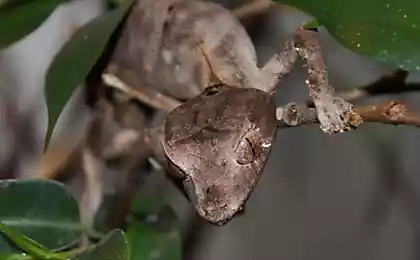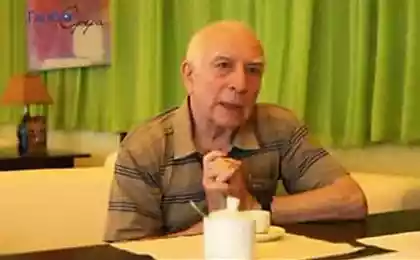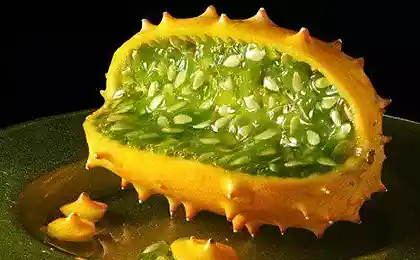2681
Physics in the animal world: the gecko's foot

Photo: Wikimedia
Geckos - the inhabitants of tropical and subtropical regions of the Old and New Worlds. These lizards live on the continents and islands, and their extensive area of distribution. Do geckos have one feature - they can be held almost any surface. the animal's body weight keeps even one paw. The surface can be any - tree, rock, even polished glass.
On the gecko's ability to cling to anything paying attention to the ancient Greeks. Aristotle tried to understand the principle of fixing legs lizards, geckos and interested in medieval scholars. Learn them, and in our time. There are several theories to explain the extraordinary ability of these lizards in "climbing".
on Suckers fingers. One of the first explanations, which seemed quite logical. However, after examination under a microscope gecko paws turned out that the suction cups on the fingers there. Unfortunately, the myth of the suckers live to this day.
Electrostatics
Denial was obtained in the 30-ies of the last century. German scientist Wolf-Dietrich Dell (Wolf-Dietrich Dellit) sent a stream of ionized air towards the gecko paws, which was held on the metal surface. Ionization, according Dellita, should neutralize or significantly reduce the adhesive force with the surface of the paws, if the clutch mechanism has an electrical nature. That did not happen, so it was concluded that geckos use something else.
Canadian scientist Alexander Penlidis believes that this experiment was flawed. The fact that the contact between the paws of a gecko and the surface is extremely cramped, so that the ionized molecules are simply unable to penetrate between the ultra-small structures and paws and neutralize surface interaction.
Clutch gecko paws with irregularities surface. This explanation is also not appropriate since geckos can move on a vertical surface of polished glass. Moreover, they can move around and the ceiling of the same material.

Photo: wikipedia
With the advent of the electron microscope gecko's paw was able to study in detail. As it turned out, it is covered with very fine bristles, the length of which is up to hundreds of micrometers. The concentration of bristles per unit area of the surface of the legs is very high: more than 14,000 hairs per 1 mm2. Each bristle, in turn, is not a monolithic form, and the end is divided into at 400-1000 even finer fibers. The thickness of such fiber is 0, 2 mm. 1 cm2 at the contact with the surface for about 2 billion fibers, each of which extends to an end.

well. B gecko foot. "Cushion" the gecko toe under a microscope. One of the gecko setae legs of she, under high magnification etc. Maximizing bristles (photo: somuchnews).
American scientists have found that the adhesive force gecko paws currents of 10 Newton per 1 cm2. Such coupling is possible only for smooth surfaces, which involved almost all the fiber of animal paws. When it comes to surfaces, often found in the habitat of geckos - rocks, trees, here involved only part of the fibers in the legs (due to the large number of irregularities on the surfaces of these), but it is enough to hold the animal in place.
As it turned out, the microscopic hairs on a gecko's feet are engaged with the supporting surface by means of van der Waals forces. Van der Waals forces - intermolecular forces (and interatomic) interaction with an energy of 10-20 kJ / mol. The basis of the van der Waals forces make up the Coulomb force of interaction between the electrons and the nuclei of a molecule and the other nuclei and electrons. At a certain distance between the molecules of attractive and repulsive forces cancel each other, and form a stable system. That such a system and is the gecko's foot to the surface with which it comes into contact.
The complex structure of legs and provides yet another of its property - hydrophobicity. Lapa repels water and dirt, allowing the gecko is a good idea to move around and wet surfaces.
Gecko paw easily detaches from the surface on which it is mounted. For this purpose, a special mechanism. The fact that attach to any material seta can detach easily, if the angle between the fiber and the surface will be more than 30 °. When driving, changing the angle of contact legs and surface, the gecko can easily detaches fixes and legs. Energy consumption for this process are minimal.
Force Vand der Waals, or something else? Two years ago, a Canadian scientist Alexander Penlidis (Alexander Penlidis) decided to study the mechanism of adhesion of gecko paws to surfaces. As it turned out, in contact legs and there is an exchange surface electric charges. As a result, a positive electrostatic charge is formed at the legs and negative - on the surface.
Penlidis experimented with two types of polymer surfaces - Teflon AF and polydimethylsiloxane. According to the conclusions made by scientists on the results of the study, the adhesion force is correlated with the magnitude of electrostatic charge legs and surface. It follows from this that it is an electric charge plays a major role in engagement with the surfaces of the paw.

The study interesting, but it does not answer the important question - how the gecko rests on very uneven surfaces, where adhesion to ensure the use of the electric charge is much more difficult than on a flat surface. Perhaps gecko feet have a double clutch mechanism -. And the Van der Waals force, and electric charge
Effect of water In most cases, scientists conducted experiments with geckos in a dry environment. Scientists from the University of Akron decided to test how well the lizard can move through moist surfaces. As it turns out, if you spray water on a glass plate, the animal is kept on such a surface is much worse than on the same plate without water drops.
However, to stay on the wet surface of the gecko manages. But if plate shallowly immersed in water, and again gecko placed on the plate, it can not hold a lizard on the surface in such conditions. If the gecko's feet plunge into the water for half an hour, and then put it on the glass, he slips off, unable to gain a foothold.
According Alyssa Stark (Alyssa Stark) from the University of Akron, this is because the water prevents the forces of van der Waals interactions and gecko's paws can not gain a foothold on the surface.
Not only the legs in the mechanism of fixing paws on the surface of the whole body is involved gecko, say scientists from the University of Massachusetts at Amherst. reptile's body, according to Alfred Crosby (Alfred Crosby), plays the role of a spring, which presses the leg to the surface. The more weight the gecko, the more this spring. Through this mechanism in any surface are kept perfectly and larger species of geckos, and not only their small family.
Despite the fact that Alexander Penlidis able to prove the effect of the electric charge on the adhesiveness of the gecko paws, most experts still maintain the point of view of the clutch mechanism on the basis of the Van der Waals forces. Now scientists are trying to explain another interesting problem - the origin of this mechanism in the process of evolution.
«Gekkonovy Scotch" Since then, as the mechanism of the gecko's feet as a whole became clear, people are trying to vocproizvesti it artificially. In particular, the DARPA agency established climbing equipment that allows a person with a mass of 122 kg (body weight + payload) to climb the glass steep wall to a height of 7, 6 m. Engineer from Stanford University created a robot that can climb almost sheer, smooth surface. Robot Manipulators also modeled on gecko feet. And experts from the University of Pennsylvania have developed a new type of high-precision grip, which can be used in production for fine detail work. Being and development sverhkleykogo adhesive tape that can withstand a lot of use cycles, and whose surface is not contaminated with prolonged use. In NASA have developed a special attachment that can be used as the Earth's environment, and in conditions of weightlessness in space. It allows you to attach loads to the surface using a special "Velcro", created in the image of the surface of a gecko's feet.
Source: geektimes.ru/post/278884/
The history of camouflage and technologies "invisibility"
The birth, rise and death of the telegraph























